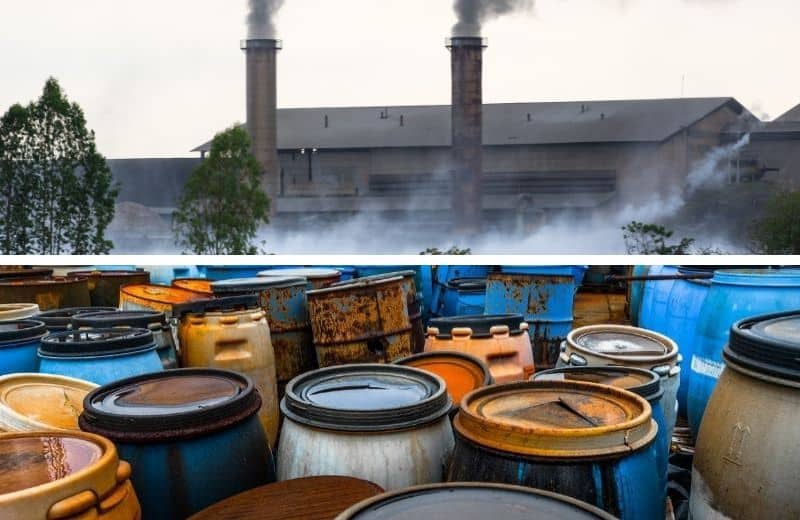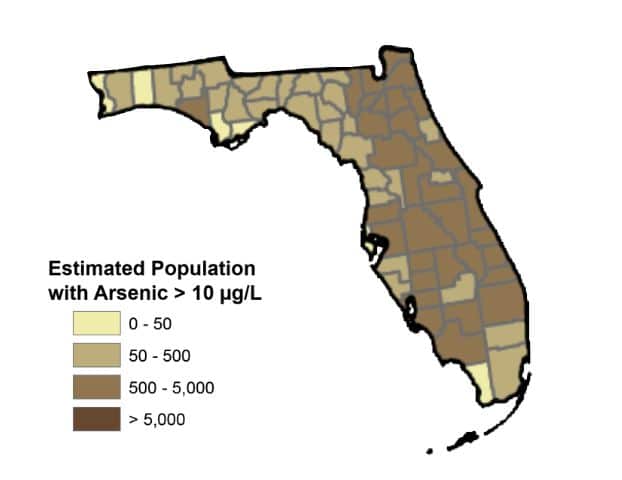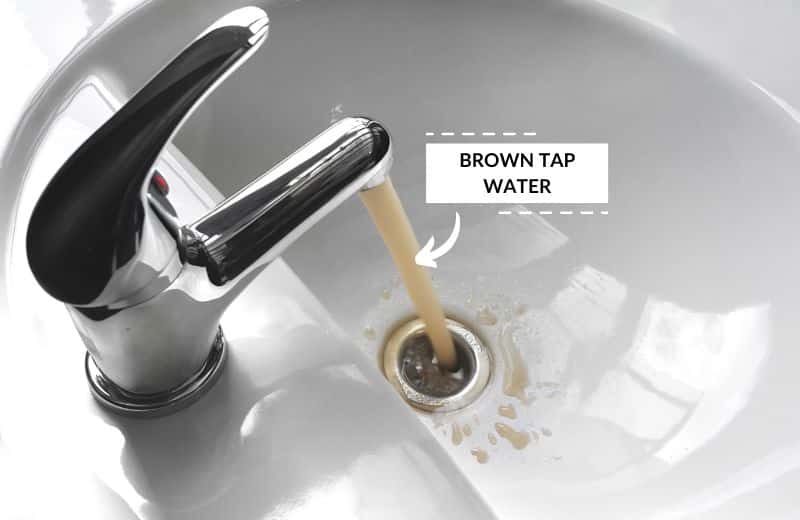Whether you’re traveling to Florida or you’re a long-time resident of the state, you might be wondering about the safety of Florida’s water.
Is Florida’s tap water safe to drink? The short answer is yes. Like all states, Florida’s governments are legally required to follow federal guidelines on water quality.
However, although Florida’s tap water is safe to drink, it still contains above-guidelines amounts of several contaminants that could, in excess, be harmful to your health.
In this guide, I’ll be looking at whether tap water is safe in all areas of Florida, and which impurities are found above the Environmental Working Group’s guidelines in Florida’s drinking water.
Table of Contents
🚰 Can You Drink Florida Tap Water?
Yes, you can drink tap water in Florida, and the water is considered safe to drink.
The contaminants found in Florida’s tap water are typically lower than the MCLs (Maximum Contaminant Levels) set by the Environmental Protection Agency (EPA).
However, the Environmental Working Group protests some of the MCLs set by the Environmental Protection Agency, saying that the limits should be stricter.
So, what does that mean? According to the EPA, Florida’s public water is safe to drink. According to the EWG, it isn’t.
Additionally, a study found that Florida’s water ranks second-worst in the nation, which isn’t exactly a positive indication about water quality.
It’s worth learning about the water quality in your town and deciding whether, in your eyes, your water is safe to drink.
👉 Check out our post to learn more about which states have the worst tap water in the US.
🗺️ Where Does the Tap Water in Florida Come From?
Florida’s drinking water is sourced from groundwater sources.
Aquifers deep beneath the surface of the ground are formed in air pockets between sediment and rock layers. When it rains, the water seeps deep beneath the surface, filters through the underground rocks and sediment, and enters the aquifer.
The water in Florida’s aquifer is rich in minerals and metallic compounds. Once the groundwater is extracted from the aquifer and brought above ground, it is treated in public water systems to remove these contaminants.

Related: Do you need a water softener in Florida?
☣️ Contaminants Found Above Guidelines in Tap Water in Florida
To take a deep dive into the quality of Florida water, I looked at the Water Quality Report produced by the Environmental Working Group for Florida. Here’s what the findings told me.
Total trihalomethanes (TTHMs)
More than 20 million residents in Florida – nearly the entire Florida population – are served water containing above-health-guidelines quantities of total trihalomethanes (TTHMs). 1,468 utilities don’t remove this contaminant as per the EWG’s recommendations.
TTHMs are volatile, potentially toxic chemicals that are produced as a byproduct to water disinfection with chlorine. Chloroform is the most commonly-found TTHM in public water systems. TTHMs are thought to have negative health effects including reproductive problems and cancer.
Haloacetic acids (HAA5)
Almost the same number of Florida residents – more than 20 million – receive water that contains above-health-guidelines levels of Haloacetic acids (HAA5). A total of 1,394 utilities deliver water containing excessive quantities of this contaminant to their customers.
Haloacetic acids are another group of disinfection byproducts that are produced when chlorine reacts with other naturally occurring chemicals in drinking water. HAA5 has similar health effects to TTHMs, including some cancers and reproductive issues.
Chromium (hexavalent)
Just over 15 million Florida residents drink tap water containing amounts of hexavalent chromium that the EWG deems unsafe to health. Just under 300 public water systems don’t remove this contaminant to below-harmful levels during water treatment.
Hexavalent chromium is a form of chromium, a metallic element, that is typically produced during industrial processes. Exposure to large quantities of hexavalent chromium is linked to kidney and liver damage, cancers, and skin irritation.

Radium
Radium – both 226 and 228 – is present in above-safe levels in 1015 utilities. Just under 15 million residents in Florida receive drinking water that contains quantities of radium above health guidelines.
Radium gets into water in underground aquifers due to local geology. Around 20% of radium is absorbed by the human body. Large quantities of radium in a water supply may cause cancer, birth defects, and kidney damage.
Arsenic
Around 11 million residents in Florida drink higher-than-safe quantities of arsenic in drinking water supplied by more than 700 water systems.
Industrial and agricultural pollution, and natural deposits in the earth, are responsible for arsenic contamination in groundwater. A large amount of arsenic can be deadly. Health effects range from a sore throat and vomiting to irritated lungs, muscle weakness, and cancer.
Chlorate
224 utilities deliver water contaminated by excessive chlorate, resulting in more than 10 million Florida residents drinking higher quantities of this contaminant than the EWG recommends.
Chlorate enters water through disinfectant use or contamination from pesticide runoff. Chronic exposure to chlorate in drinking water can affect the body’s ability to absorb iodine. This is particularly dangerous to children.

Nitrate
More than 7 million residents in Florida receive a water supply that contains higher-than-recommended levels of nitrate. 750 utilities deliver this water, while more than 1,100 utilities deliver water contaminated with some (not necessarily at harmful levels) nitrate.
Too much nitrate can affect the blood’s ability to carry oxygen around the body. Nitrate-contaminated water is especially dangerous to pregnant women, and carries the risk of blue baby syndrome.
Uranium
135 utilities deliver uranium-contaminated water to more than 3 million citizens in Florida.
Uranium in water comes from natural uranium ores. This radioactive substance is a normal part of air, soil, rocks, and water. However, drinking uranium can be dangerous, leading to inflammation, kidney damage, and changes in urine composition.
Perfluorooctane sulfonate (PFOS)
Higher-than-safe levels of perfluorooctane sulfonate (PFOS) is consumed by more than 3 million Florida residents in drinking water supplies. 26 utilities are known to deliver unsafe levels of this chemical to their customers.
PFOS is a manmade chemical that is classed as a “forever chemical” because it exists in the environment for a very long time. PFOS has known health effects including developmental effects in babies and children, immune effects, liver effects, cholesterol changes, thyroid effects, and more.

🏙️ Tap Water Quality in the Major Cities
Miami
An EWG Water Quality Report of Miami Dade County found a total of 24 contaminants in the County’s water, with 8 contaminants that exceed the EQG’s health guidelines. However, tap water in Miami is in compliance with federal drinking water standards set by the EPA.
Miami has four water systems, and one of these four systems provides tap water with a very high copper content. This system supplies a small part of Miami between Southwest 184 Court and Southwest 189th Avenue.
Arsenic is another big problem in Miami. The EWG’s Miami report detected 243x the amount of arsenic – 0.971 ppb – than the EWG’s health guideline – 0.004 ppb.
Jacksonville
A total of 34 contaminants were detected in an EWG Water Quality Report of Jacksonville’s water. 13 of these contaminants were found to exceed the EWG’s health guidelines. Water in Jacksonville is considered safe according to guidelines by the EPA.
Although Jacksonville’s lead and copper levels are below the legal limit, the city’s water contains excessive levels of trihalomethanes. The EWG report also detected high levels of arsenic in Jacksonville’s water – 20x the EWG’s health guideline of 0.004 ppb.
Tampa
The City of Tampa Water Department provides water with a total of 18 contaminants to its customers, according to an EWG Water Quality Report. 6 of these contaminants exceed the EWG’s health guidelines, but the water is in compliance with federal drinking water standards.
Tampa’s tap water is safe to drink, containing safe levels of trihalomethanes, arsenic, copper, chlorine, and more. However, the EWG flags arsenic as a problem contaminant in Tampa’s water system, being present in amounts 198x the EWG’s health guidelines.

Orlando
An EWG Water Quality Report on the Orlando Utilities Commission found that Orlando’s water contains a total of 16 contaminants, 5 of which exceed the EWG’s health guidelines. Again, Orlando’s water is in compliance with the EPA’s drinking water standards.
Orlando is another Florida city that supplies high water levels of trihalomethanes. The EWG also detected more than twice the amount of hexavalent chromium in Orlando’s water than the EWG recommends, as well as 192x the amount of Haloacetic acids (HAA5).
💬 Frequently Asked Questions
Why Does Florida Water Taste Bad?
There are a number of contaminants in Florida’s water that contributes to poor taste (and smell). Many people drink exclusively bottled water in Florida, and there are several drinking water contaminants that are to blame.
The most common taste complaints about Florida’s water are a metallic taste, a taste of chemicals, a rotten egg taste/odor, and a salty taste.
Contaminants like sulfur, copper, iron, metals, manganese, chloramine, and chlorine can all affect the quality of water, changing the way it tastes.
Why is Florida Tap Water Yellow?
Taste isn’t the only factor that may be off with your water in Florida. You might have noticed that your tap water has a yellow tinge. This can be caused by several contaminants, and the most common cause is dissolved organic materials.
Chlorination and metals can also cause yellow-tinged drinking water. Yellow drinking water is generally safe, but doesn’t look very appealing.

Is the Tap Water in Florida Fluoridated?
Yes. The majority of Florida’s drinking water is fluoridated. Fluoride is added to water for its oral health benefits, but it can affect the way water tastes, and there’s contesting information about the health effects of drinking fluoride in water. Some of Florida’s counties have naturally-occurring fluoride in their water.
Will Boiling Water Remove Florida’s Contaminants?
No. Boiling water will help with chlorine and chloramine (two common water disinfectants) evaporation, but it won’t remove any other non-biological contaminants . When you boil water, you just end up evaporating some of the water, resulting in more highly-concentrated contaminated water.
Is it Better to Drink Bottled Water if you Live in Florida?
Many people in Florida drink bottled water because it tastes so much better than their local drinking water. There’s also a reduced health risk from drinking bottled water. Unfortunately, while bottled water might be better for you, it isn’t better for the environment.
Drinking bottled water is better than drinking Florida’s tap water. But the ideal solution is to remove the contaminants from your tap water with a filtration solution. At-home water filtration is an environmentally-friendly alternative to buying bottle after bottle of water, and it tends to be cheaper in the long run, too.

I live in a superfund area 32060. The water is yellow and smells and even with a filter on the sink and on the well I still have coliforms. If it is a superfund site shouldn’t the pollluters be responsible for providing resources to help filter the water or at least comprehensive testing?
Hi Iris, the issues you are mentioning may not even be related to the original superfund contamination. Doing a quick search, I see that superfund site has been removed from the national priorities list “Because no hazardous wastes remain on site”.
As you mentioned, the best place to start is with a comprehensive lab test. It sounds like you already have some water treatment systems in place. I would advise testing both before and after the current treatment so you can get a good idea if it is sufficient, what might be lacking, and how well the system is performing based on the water issues present.
Thank you
You’re welcome!